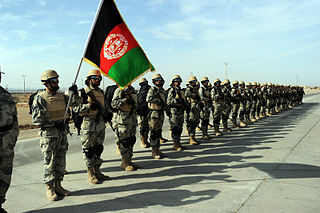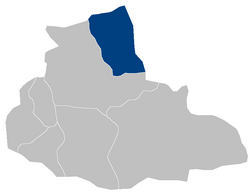
Kunduz is a city in northern Afghanistan, the capital of Kunduz Province. The city has an estimated population of about 268,893 as of 2015, making it about the 7th-largest city of Afghanistan, and the largest city in northeastern Afghanistan. Kunduz is in the historical Tokharistan region of Bactria, near the confluence of the Kunduz River with the Khanabad River. Kunduz is linked by highways with Kabul to the south, Mazar-i-Sharif to the west, and Badakhshan to the east. Kunduz is also linked with Dushanbe in Tajikistan to the north, via the Afghan dry port of Sherkhan Bandar. This city is famous in Afghanistan for its watermelon production.

Faryab is one of the thirty-four provinces of Afghanistan, which is located in the north of the country bordering neighboring Turkmenistan. It has a population of about 1,109,223, which is multi-ethnic and mostly a tribal society. The province encompasses 15 districts and over 1,000 villages. The capital of Faryab province is Maymana. It also borders Jowzjan Province, Sar-e Pol Province, Ghor Province and Badghis Province.

The Taliban insurgency began after the group's fall from power during the 2001 War in Afghanistan. The Taliban forces fought against the Afghan government, led by President Hamid Karzai, and later by President Ashraf Ghani, and against a US-led coalition of forces that has included all members of NATO; the 2021 Taliban offensive resulted in the collapse of the government of Ashraf Ghani. The private sector in Pakistan extends financial aid to the Taliban, contributing to their financial sustenance.
Bala murghab is a district situated in the northeast of Badghis Province, Afghanistan. The district capital is Bala Murghab city which is located along the Murghab River. Bala Murghab is surrounded by some other important districts such as Ab Kamari, Muqur, Jawand, and Qadis.
Maulvi Faqir Mohammed is an Islamist militant and, until March 2012, a deputy leader of the Pakistani Taliban umbrella group Tehrik-i-Taliban Pakistan. He was reported as killed on 5 March 2010 during a helicopter gunship attack on militants by the Pakistani military although he denied the reports as false. In July 2011, he resurfaced on the air broadcasting radio shows out of Afghanistan. He was captured in Afghanistan on 17 February 2013, and released by the Afghan Taliban in 2021.
The following lists events that happened during 2004 in Afghanistan.

Bala Murghab is a city in the Badghis province of northwestern Afghanistan, located on the Murghab River. It is the district center for the Bala Murghab District. Bala Murghab is the largest city of Badghis Province, while Bala Murghab District, with a population of 109,381, is also the most populous district of the province. Close to Bala Murghab lie the ruins of the medieval city Marw al-Rudh, the historical capital of the medieval region of Gharjistan. Throughout the War in Afghanistan, it was heavily contested by the Taliban and Afghan National Security Forces. The city was captured by the Taliban during the 2021 Taliban offensive.

The Pakistani Taliban, officially called the Tehreek-e-Taliban-e-Pakistan, is an umbrella organization of various Islamist armed militant groups operating along the Afghan–Pakistani border. Formed in 2007 by Baitullah Mehsud, its current leader is Noor Wali Mehsud, who has publicly pledged allegiance to the Afghan Taliban. The Pakistani Taliban share a common ideology with the Afghan Taliban and have assisted them in the 2001–2021 war, but the two groups have separate operation and command structures.

The Balamorghab ambush occurred on 27 November 2008, when vehicles carrying Afghan security forces were attacked by Taliban insurgents led by Ghulam Dastagir. The ambush took place near Balamorghab in Badghis Province, in northwestern Afghanistan, and resulted in heavy casualties for the government forces. It was described as "one of the most humiliating attacks the Afghan security forces had ever suffered".

Bādghīs is one of the thirty-four provinces of Afghanistan, located in the northwest of the country, on the border with Turkmenistan. It is considered to be one of the country's most underdeveloped provinces, with the highest poverty rate. The capital is Qala e Naw, while the most populous city and the district are Bala Murghab. The ruins of the medieval city of Marw al-Rudh, the historical capital of the medieval region of Gharjistan, are located in the province near the modern city of Bala Murghab.

The Afghan Border Force (ABF) was responsible for security of Afghanistan's border area with neighboring countries extending up to 30 miles (48 km) into the interior and formed part of the Afghan National Army. In December 2017, most of the Afghan Border Police (ABP) personnel of the Afghan National Police were transferred to the Afghan National Army to form the Afghan Border Force. The ABP retained 4,000 personnel for customs operations at border crossings and international airports such as checking documents of foreigners entering the country or deporting them.
The Battles of Mazar-i-Sharif were a part of the Afghan Civil War and took place in 1997 and 1998 between the forces of Abdul Malik Pahlawan and his Hazara allies, Junbish-e Milli-yi Islami-yi Afghanistan, and the Taliban.
The following lists events that happened during 2015 in Afghanistan.
Events in the year 2018 in Afghanistan.

The Ghazni offensive began on 10 August 2018, when Taliban fighters launched an assault on the city of Ghazni, Afghanistan's sixth largest city and one which has been culturally and strategically important for much of the country's history. The attack resulted in the deaths of hundreds of insurgents, soldiers, police, and civilians. The city also sustained large-scale property damage. The battle, occurring only weeks before Afghanistan's 2018 parliamentary election, was the largest since a three-day truce in June had raised hopes of peace talks.
Events from the year 2019 in Afghanistan.

The Islamic State–Taliban conflict is an ongoing armed conflict between the Islamic State and the Taliban in Afghanistan. The conflict escalated when militants who were affiliated with Islamic State – Khorasan Province killed Abdul Ghani, a senior Taliban commander in Logar province on 2 February 2015. Since then, the Taliban and IS-KP have engaged in clashes over the control of territory, mostly in eastern Afghanistan, but clashes have also occurred between the Taliban and IS-KP cells which are located in the north-west and south-west.
In a continuation of previous attacks by the Taliban in May and June, multiple clashes between Afghan security forces and the Taliban were reported. They carried out several attacks throughout Afghanistan, resulting in multiple fatalities on both sides. Both the Taliban and government forces have accused each other responsibility over the recent surge in violence across Afghanistan. The attacks come despite the signing of a peace deal with the U.S. in February that was intended to put an end to the war.
2021 (MMXXI) was a common year starting on Friday of the Gregorian calendar, the 2021st year of the Common Era (CE) and Anno Domini (AD) designations, the 21st year of the 3rd millennium and the 21st century, and the 2nd year of the 2020s decade.

The republican insurgency in Afghanistan is an ongoing armed conflict between the National Resistance Front and allied groups which fight under the banner of the Islamic Republic of Afghanistan on one side, and the Islamic Emirate of Afghanistan on the other side. On 17 August 2021, former first vice president of Afghanistan Amrullah Saleh declared himself the "caretaker" president of Afghanistan and announced the resistance. On 26 August, a brief ceasefire was declared. On 1 September, talks broke down and fighting resumed as the Taliban attacked resistance positions.












